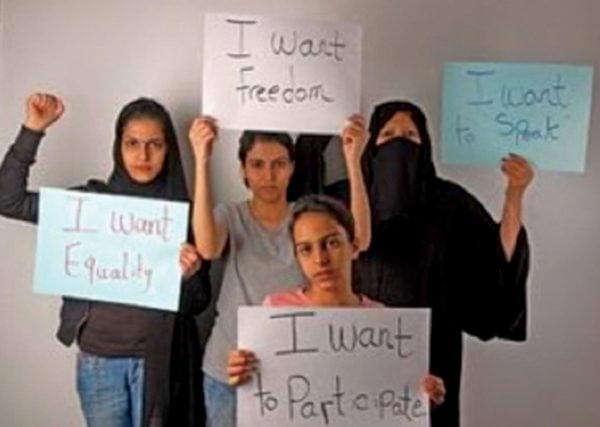
Female stereotyping across advertising in the Middle East is creating only a ‘semi representation’ of women. But are things changing?
A dashing prince rides on a gleaming stallion against a spectacular mountain backdrop. Meanwhile his seductively-yet-subtly beautiful beloved bathes in rose petals, decks herself in diamonds and awaits her Prince Charming’s arrival. All very done and Disney. Except while Disney is in fact pushing gender stereotypes with its latest heroines – all hail Queen Elsa – this example of a Lebanese jewellery advert goes right back to the medieval era of women behind walls and men leading the charge. Though the male figure also plays into a constructed gender role, his is once again the active player while hers is passive and completely lacking in agency.
This example may be an extreme, one only needs to look across the spectrum of work – whether in the guise of a campaign or a press release – to see that such passive stereotypes are far from uncommon. If not figures of beauty to be gazed at, the next most likely woman to be seen is the mother or housewife. Even Impact BBDO’s ground-breaking ‘Give mom back her name’, which challenged cultural perceptions of the mother figure, let the men do all the talking; once again she was the passive person.
But are these prevalent stereotypes a misrepresentation of women or merely mirroring the roles they still largely play in society today? The issue is a contentious one.
For Tanya Dernaika, training leader at Memac Ogilvy, the issue is not so much
of misrepresentation, but ‘semi-representation’. “I don’t think women are misrepresented any less stereotypically than men are in Middle East advertising,” she says. “But only a couple of facets of a woman’s life are featured in advertising and the other multitude of facets are not sufficiently acknowledged.
“Yes, Arab women are house-proud; they cook, clean and do the laundry and they see no shame in that. Yes, the majority are also great mothers and they do spend a significant proportion of their time grooming and taking pride in their appearance. There is no question that all these facets of an Arab woman’s life are relevant, but most of these same women are also participating in the workforce, supporting their husbands financially, juggling jobs and homes, creating and building businesses, winning awards in their career fields and providing inspiration to others, but we see much less of that. What we don’t see is their intelligence being acknowledged as much in advertising and their sense of humour even less so. What we lack is advertising tailored to engaging and entertaining an Arab woman’s mind and sophistication – the tendency is to focus on the basic and functional. There is certainly opportunity for brands to connect better, in stronger more engaging ways.”
Rana Khoury, creative director at Leo Burnett Beirut, echoed Dernaika’s comments, saying: “One of the biggest misrepresentations of women in advertising in the Middle East is probably their stereotyping. Representing women as ‘one kind’ limits the presence of diverse women from different walks of life, careers, and backgrounds.” However, these stereotypes are not necessarily inaccurate, she adds. “Advertising usually speaks to the society it is created in,” she says. “So for it to be relatable,
it sometimes
mirrors many aspects of this society, even the bad ones sadly.
Yes, women’s roles in this region are sometimes limited to housewives, which is visible in some ads. Don’t forget that even by law, women in some countries in the Middle East don’t have the same rights as men.
“Unfortunately, all over the world women have often been subject to misrepresentation; the difference is that in some parts of the world laws have been implemented to stop sexism from being present in advertising. But even without laws, it is an advertising agency’s duty
to act responsibly and to
pave the way to change
misconceptions.”
However, though women’s roles may often be restricted to loving mothers and caring housewives, for Lara Safar, operations director at Interesting Times, and Tala Ali, senior copywriter at Saatchi & Saatchi Dubai, ‘what’s wrong with that?’ And, rather than being passive figures, these women in fact take the lead in commercials, says Ali. “At the end of the day, women do like to take care of their families and make sure their homes are up and running as much as they like their careers or businesses to be successful. Being a housewife is one of the demanding jobs in the world. A businesswoman has her work cut out for her equally but when it comes to advertising, women are not badly represented, it’s just expected. Ideally, I’d like to see more ‘realness’ in advertising;
real stories from real people. With thorough research to back things up, done in a manner that veers away from focus groups or back-up data. So we can present women, and people in
general, not in their stereotypical roles, but as they’re living today.”
Safar adds: “I see [the housewife role] as a fair representation if we’re taking the Arab world as a whole. The actual problem isn’t in the regularity of portraying women in the kitchen per se, as much as it’s the lack of reflecting the other women – the young, the independent, the artist, the multi-tasker, the athletic, the struggling. But then again, we need to keep in mind who are the biggest advertisers in the region – this alone dictates the archetype of the woman in the ads we’re exposed to.”
And what of objectification? Though the largely conservative mindset in the Middle East means billboards of bikini-clad women are rare, are other, more subtle, forms of objectification undermining women’s contributions to society? For Dernaika, celebrity culture is as much at fault. “Women are objectified in most beauty, fashion and cosmetic advertising the world over. It’s a business that depends on selling seduction after all,” she says. “Advertisers will push the boundaries as far as they are allowed to, given the cultural sensitiveness of the market. It’s no surprise, therefore, that the Lebanese market features the ‘raciest’ images, but then men are not immune from this stereotyping either. Does it add pressure on people to live up to unrealistic images? Of course it does, but the rise
of prominence of celebrity reality TV stars has also contributed to shaping beauty ideals in unhealthy ways. Advertising is a reflection of this prevailing culture.”

She adds: “Typically female-targeted brands like Dove and Nestle (#WeighThis campaign), to name a couple, have made major strides in changing the way women are targeted and communicated to, but it’s high time brands in the traditionally male dominated categories such as financial service, car, travel and real estate recognise that women are no longer influencers, but key decision-makers and, in many cases, purse string holders too. Communication in those fields requires a major re-think.”
Likewise, Khoury agrees that while some campaigns have made headway in addressing this balance, much more can be done. “Progress has definitely been made,” she says. “It shows in the civil society that is dedicated to change the status quo, in the women’s NGOs that are on the rise in the region, and also in award-winning campaigns that are empowering women, such as Kafa campaigns and Always social experiments. More effort always needs to be made because communication helps shape the way people think and feel, so it has to be avant-gardist, and to create more campaigns that reflect women in the way women want to be portrayed. Advertising can make women realise that they can change things overnight.”
She adds: “Advertising agencies need to take a lead in changing women’s misrepresentation in society and media by portraying her as the real strong woman that she is. This can be done obviously through the campaigns and messages that are being created. But it also can be a ‘way of life’ inside the agencies themselves in the region, where women should me more present
and take lead positions in
the industry.”
Khoury’s comments point to the glaring void of women leaders across the MENA region’s industry; chief executive and chief creative officer positions in all groups and in most agencies are still occupied by men. It is no secret that the majority of women are limited to entry level and mid-level managers in most agencies. Major decision-making positions in the majority of agencies and groups are occupied by men, and most of the time, the same applies to clients.
Yet though women’s
participation at the decision-making level still evidently has a long way to go, there is at least some consolation that progress is being made, albeit slowly. Things have changed over the years, but ever so slightly”, says Ali. “And based on the work we’re putting out there, things will keep changing for the better. It’s amazing to see such bold campaigns out there that would have never even made it past the first round of client approvals had it been a few years ago. Should we continue down this path, progress will happen on its own, and not just because of brands and advertising. Everything will be bettered because of the education and knowledge that women in this region are consuming with hunger. It’s their freedom to speak up that will open up even more doors for us in the future.”
Meanwhile Safar, whose current work includes encouraging greater participation of female DJs in Lebanon for Audio Kultur and Smirnoff Sound
Collective, remains more philosophical on the overall issue. She says: “I believe we should not be relying on advertising or campaigns to remember what we are, or to love ourselves – as it all starts there – self-love. I think it’s how you see yourself that others perceive you – not how advertising campaigns depict you. Or at least that’s what I would like to think.”









